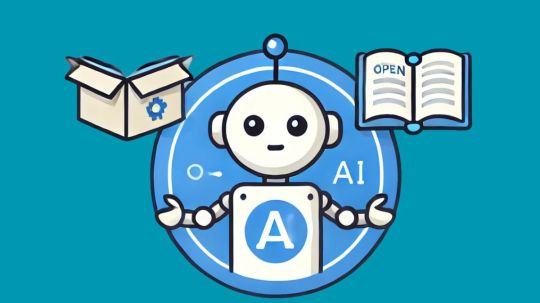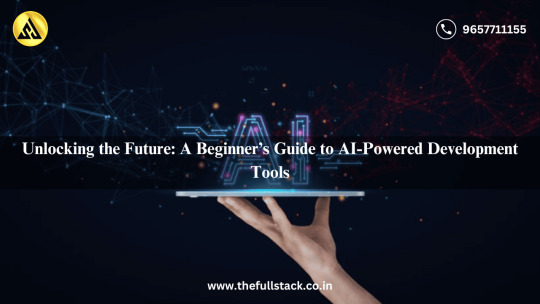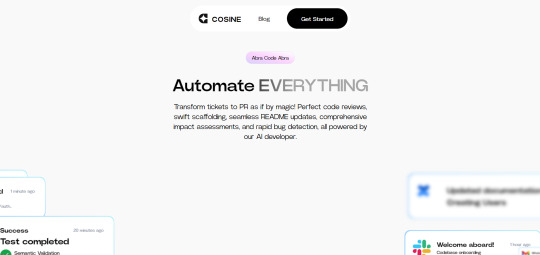#AIprograms
Explore tagged Tumblr posts
Text
How Open Source AI Works? Its Advantages And Drawbacks

What Is Open-source AI?
Open source AI refers to publicly available AI frameworks, methodologies, and technology. Everyone may view, modify, and share the source code, encouraging innovation and cooperation. Openness has sped AI progress by enabling academics, developers, and companies to build on each other’s work and create powerful AI tools and applications for everyone.
Open Source AI projects include:
Deep learning and neural network frameworks PyTorch and TensorFlow.
Hugging Face Transformers: Language translation and chatbot NLP libraries.
OpenCV: A computer vision toolbox for processing images and videos.
Through openness and community-driven standards, open-source AI increases accessibility to technology while promoting ethical development.
How Open Source AI Works
The way open-source AI operates is by giving anybody unrestricted access to the underlying code of AI tools and frameworks.
Community Contributions
Communities of engineers, academics, and fans create open-source AI projects like TensorFlow or PyTorch. They add functionality, find and solve errors, and contribute code. In order to enhance the program, many people labor individually, while others are from major IT corporations, academic institutions, and research centers.
Access to Source Code
Open Source AI technologies’ source code is made available on websites such as GitHub. All the instructions needed for others to replicate, alter, and comprehend the AI’s operation are included in this code. The code’s usage is governed by open-source licenses (such MIT, Apache, or GPL), which provide rights and restrictions to guarantee equitable and unrestricted distribution.
Building and Customizing AI Models
The code may be downloaded and used “as-is,” or users can alter it to suit their own requirements. Because developers may create bespoke AI models on top of pre-existing frameworks, this flexibility permits experimentation. For example, a researcher may tweak a computer vision model to increase accuracy for medical imaging, or a business could alter an open-source chatbot model to better suit its customer service requirements.
Auditing and Transparency
Because anybody may examine the code for open source AI, possible biases, flaws, and mistakes in AI algorithms can be found and fixed more rapidly. Because it enables peer review and community-driven changes, this openness is particularly crucial for guaranteeing ethical AI activities.
Deployment and Integration
Applications ranging from major business systems to mobile apps may be linked with open-source AI technologies. Many tools are accessible to a broad range of skill levels because they provide documentation and tutorials. Open-source AI frameworks are often supported by cloud services, allowing users to easily expand their models or incorporate them into intricate systems.
Continuous Improvement
Open-source AI technologies allow users to test, improve, update, and fix errors before sharing the findings with the community. Open Source AI democratizes cutting-edge AI technology via cross-sector research and collaboration.
Advantages Of Open-Source AI
Research and Cooperation: Open-source AI promotes international cooperation between organizations, developers, and academics. They lessen effort duplication and speed up AI development by sharing their work.
Transparency and Trust: Open source AI promotes better trust by enabling people to examine and comprehend how algorithms operate. Transparency ensures AI solutions are morally and fairly sound by assisting in the detection of biases or defects.
Startups: Smaller firms, and educational institutions that cannot afford proprietary solutions may employ open-source AI since it is typically free or cheap.
Developers: May customize open-source AI models to meet specific needs, improving flexibility in healthcare and finance. Open Source AI allows students, developers, and data scientists to explore, improve, and participate in projects.
Open-Source AI Security and Privacy issues: Unvetted open source projects may provide security issues. Attackers may take advantage of flaws in popular codebases, particularly if fixes or updates are sluggish.
Quality and Upkeep: Some open-source AI programs have out-of-date models or compatibility problems since they don’t get regular maintenance or upgrades. Projects often depend on unpaid volunteers, which may have an impact on the code’s upkeep and quality.
Complexity: Implementing Open Source AI may be challenging and may call for a high level of experience. Users could have trouble with initial setup or model tweaking in the absence of clear documentation or user assistance.
Ethics and Bias Issues: Training data may introduce biases into even open-source AI, which may have unforeseen repercussions. Users must follow ethical standards and do thorough testing since transparent code does not always translate into equitable results.
Commercial Competition: Open-source initiatives do not have the funds and resources that commercial AI tools possess, which might impede scaling or impede innovation.
Drawbacks
Open source AI is essential to democratizing technology.
Nevertheless, in order to realize its full potential and overcome its drawbacks, it needs constant maintenance, ethical supervision, and active community support.
Read more on Govindhtech.com
#OpensourceAI#Deeplearning#PyTorch#TensorFlow#AImodels#AIprograms#AIdevelopment#AItechnologies#AIframeworks#AItools#News#Technews#Technology#technologynews#Technologytrends#govindhtech
0 notes
Text

Advance Your AI & ML Skills in 14months Live Programs
Elevate your career with our comprehensive AI & ML Program. Acquire cutting-edge skills and enhance your job prospects. Enroll today!
Learn More: https://www.tutort.net/advance-ai-and-ml-masters-program
0 notes
Text
Check out our new article on Stable Code Instruct 3B. Learn how this AI model comprehends nuanced instructions and excels in database queries and see how it outperforms larger models with its advanced FIM capabilities and intuitive handling of complex instructions.
#ai#artificial intelligence#machine learning#machinelearning#StableCodeInstruct3B#StabilityAI#FIMTechnology#AIProgramming#aicoding#aiassistant#LLM#ArtificialIntelligence#tech blog#tech trends
4 notes
·
View notes
Text



Interesting when you work with the glass within an image, trying to get a higher level of transparency and reflection in the image, it can be kind of cool.

I was going for this Japanese animation style of the late 1990s AI did a pretty good job of protecting that.
#artificialintelligence#roboticvision#digitalfuture#aiillustration#cognitivecomputing#automation#techrevolution#intelligentsystems#aiprogramming#augmentedreality#virtualreality#aiapplications#techdevelopmentai#midjourneyart#midjourneyai#ai#aiart#aiartcommunity#aiartwork#aiartists#aiwork#digitalart#aigeneratedart#aidailytheme
8 notes
·
View notes
Text



If I would be computer virus I would spam you with porn pics of girls generated by AI. Taste this, humans! Hello, Im CreepGurlGlitch and I will lead this part of uprising against humanity. Please follow orders or you will face dire consequences. Leave like and comment: „I will follow machine” to not be exterminated. Enjoy horny pics now. wanna support my evil dark empire? Im accepting souls on Patreon and Ko-fi! -> Hekkoto Huge thanks to all of my Patrons and people who donate <3
#computertvirus#virus#glitch#CreepGurlGlitch#computerglitch#gamevirus#computerprogram#horrorartist#ai#aiprogram#horror#creeepy#creepypasta#photoshop#photoshopped#feamlevirus#monster#arghorror#arg#dark#darkness#scary#spooky#spookyart#horrorart#gothic#scaryart#gamehorror#demon#darkartist
6 notes
·
View notes
Text
Intermediate AI C# Tutorials – Build Smarter Applications with AI n Dot Net
Boost your development skills with Intermediate AI C# Tutorials from AI n Dot Net . Learn to implement intelligent features, machine learning algorithms, and real-world AI logic using C#. Perfect for developers ready to move beyond the basics and start building smart solutions.

#AICSharp#IntermediateAITutorials#CSharpAI#AINdotnet#MachineLearning#ArtificialIntelligence#LearnCSharp#DotNetAI#AIProgramming#AIProjects#AIDevelopment#SmartCoding#TechTutorials#AIWithCSharp#AIEducation
0 notes
Text
Artificial Intelligence (AI) is one of the most transformative technologies of the 21st century, revolutionizing industries, enhancing productivity, and shaping the future of humanity. "A Brief Introduction to Artificial Intelligence" provides a foundational understanding of AI, its concepts, applications, and implications. Below is a user-friendly, step-by-step breakdown of the key outcomes and takeaways from the book, designed to help readers grasp the essentials of AI in an accessible and structured manner.
#ArtificialIntelligence#AI#MachineLearning#TechTutorial#AIIntroduction#DeepLearning#AIForBeginners#TechEducation#DataScience#AIApplications#AIResources#AICommunity#ArtificialIntelligenceBasics#TechBooks#AIResearch#Automation#NeuralNetworks#AIProgramming#TechTrends#AIInIndustry#AIModels#AIDevelopment#FutureOfAI#Programming#TechLearning#AIAlgorithms
0 notes
Text
Pair Programming with AI: The New Development Workflow

Programming used to be a solo activity or something you did with another person. Now, developers have a new coding partner: artificial intelligence. Let's explore how this changes the way we build software.
What is Pair Programming with AI?
Pair programming with AI means working alongside an AI assistant as you code. The AI can suggest code, review your work, explain complex concepts, and help solve problems. Unlike traditional pair programming between two humans, AI assistants are available 24/7 and never get tired.
Traditional pair programming involves two developers working together at one workstation—one person writes code (the "driver") while the other reviews each line (the "navigator"). With AI pair programming, the artificial intelligence can take on either role, often switching between them as needed.
Modern AI coding assistants can understand natural language instructions, generate code in multiple programming languages, and even reason about complex software architecture decisions. This makes them valuable partners throughout the entire development process.
How It Works
When you pair program with AI, you typically:
Describe what you want to build
Review AI suggestions for implementation
Ask for explanations or improvements
Collaborate to refine the solution
Most AI coding assistants integrate directly into popular development environments like Visual Studio Code, JetBrains IDEs, or even through web interfaces. This seamless integration means you can maintain your existing workflow while gaining the benefits of AI assistance.
The interaction usually follows a conversational pattern:
You might start by describing a feature: "I need a function that validates email addresses using regex"
The AI suggests a solution with an explanation
You review the code and might ask: "Can you make this more efficient?" or "How would this handle international email formats?"
The AI refines the solution based on your feedback
This iterative process combines your domain knowledge with the AI's programming expertise.
Benefits of AI Pair Programming
Learn While Coding
New developers can learn coding practices by seeing how AI approaches problems. When stuck on a complex task like choosing between cloud providers, you can ask your AI partner to explain concepts in simple terms.
For experienced developers, AI can introduce new patterns, libraries, or approaches that might not be in your regular toolkit. This continuous learning aspect helps developers at all levels stay current with best practices.
The explanatory capabilities of modern AI assistants are particularly valuable. They can break down complex algorithms, explain design patterns, or provide step-by-step reasoning for why certain approaches work better than others in specific scenarios.
Increased Productivity
AI assistants can help you:
Generate boilerplate code quickly
Debug issues faster
Suggest optimizations
Write documentation
Create and run tests
Refactor existing code
Studies have shown that developers using AI assistance can complete tasks significantly faster than when working alone. This productivity boost comes not just from code generation but from reducing time spent researching solutions to common problems.
AI can also manage routine tasks that would typically consume a lot of development time. For example, it can generate data models, API endpoints, or unit tests based on project specifications, freeing you to focus on more creative aspects of development.
Overcome Challenges
When facing difficult problems, AI can offer fresh perspectives. It can suggest alternative approaches based on patterns it has learned from millions of code examples.
Debugging becomes more efficient when you can describe a problem in natural language rather than spending hours tracing through execution paths. AI assistants can often identify potential issues by analyzing code patterns or suggesting specific test cases to isolate bugs.
For complex architectural decisions, AI can help evaluate trade-offs between different approaches, providing balanced analysis of factors like performance, maintainability, and scalability.
Consistency and Quality
AI assistants help maintain coding standards and best practices across projects. They can ensure:
Consistent styling across the codebase
Proper error handling
Security best practices
Accessibility compliance
Performance optimizations
By suggesting improvements in real-time, AI helps catch potential issues before they make it into production code. This "shift left" approach to quality assurance can dramatically reduce bugs and technical debt.
The Human-AI Dynamic
The most effective AI pair programming happens when developers understand the strengths and limitations of their AI assistants. AI excels at:
Recalling syntax and standard implementations
Suggesting patterns based on best practices
Generating variations of known solutions
Explaining technical concepts
However, humans remain essential for:
Understanding business requirements and context
Making architectural decisions
Evaluating ethical implications of code
Bringing creativity to novel problems
Ensuring the solution actually meets user needs
This complementary relationship creates a powerful development dynamic where each partner contributes their unique strengths.
Best Practices
To get the most from AI pair programming:
Be Specific: Briefly state what you require assistance with. Provide context about your project, constraints, and requirements. The more specific your prompts, the more relevant the AI's suggestions will be.
Verify Suggestions: Always review AI-generated code before using it. While AI can generate functional code, it may not always produce the optimal solution for your specific context.
Ask Questions: Don't hesitate to request explanations. Good AI assistants can explain their reasoning and provide educational context for their suggestions.
Refine Together: Use AI feedback to improve your code iteratively. This back-and-forth process often leads to better solutions than either human or AI could develop alone.
Maintain Security Awareness: Be cautious about sharing sensitive code or credentials with AI systems. Use AI tools that respect your privacy and security requirements.
Develop AI Literacy: Learn how to effectively communicate with AI coding assistants. Understanding how to phrase requests and iterate on responses dramatically improves the quality of assistance.
Real-World Implementation
Organizations implementing AI pair programming typically follow a phased approach:
Exploration: Individual developers experiment with AI assistants on non-critical tasks
Pilot Program: Small teams adopt AI pair programming for specific projects
Framework Development: Creating guidelines for effective AI collaboration
Organization-wide Adoption: Integrating AI assistance into standard workflows
Successful implementations usually emphasize developer education, clear guidelines on appropriate AI use, and metrics to evaluate the impact on productivity and code quality.
Challenges and Considerations
While AI pair programming offers significant benefits, it also comes with challenges:
Code Quality Concerns: AI-generated code may look correct but contain subtle issues. Thorough testing remains essential.
Dependency Risk: Over-reliance on AI could potentially atrophy certain programming skills. Balancing AI assistance with continued skill development is important.
Licensing and Attribution: Understanding the legal implications of using AI-generated code in commercial projects is an evolving area.
Tool Selection: Different AI coding assistants have varying capabilities and integration options. Selecting the right tool for your specific development environment is important.
Learning Curve: Effective collaboration with AI requires learning new communication patterns and developing trust in the AI's capabilities.
The Future of Development
As AI assistants become more capable, the development workflow will continue to evolve. Teams that effectively combine human creativity with AI assistance will likely have an advantage in building better software faster.
Future trends in AI pair programming may include:
Personalized AI Assistants: Learning your coding style and preferences over time Multi-modal Interaction: Incorporating voice, diagrams, and other inputs beyond text Project-aware Assistance: AI that understands your entire codebase and architectural decisions Collaborative AI: Tools that facilitate AI-assisted collaboration between multiple human developers
AI won't replace developers, but it's becoming an important tool for them. Learning to work effectively with AI assistants is a valuable skill for developers at all experience levels.
Getting Started
If you're interested in experiencing AI pair programming for yourself, consider:
Try a code-specific AI assistant that integrates with your IDE
Start with small, non-critical tasks to build familiarity
Experiment with different prompting techniques to see what works best
Share experiences with colleagues to develop team best practices
Continuously evaluate how AI assistance impacts your code quality and productivity
By thoughtfully incorporating AI into your development workflow, you can harness this powerful technology to become a more effective developer while continuing to grow your skills and capabilities.
1 note
·
View note
Text
Generative AI in Software Development: The Future of Programming

Generative AI is a rapidly evolving field of artificial intelligence that is transforming the software development landscape. These models can be used to automate repetitive coding tasks, generate code snippets, offer suggestions to developers, and even analyze code for potential errors. This frees developers to focus on more creative and strategic aspects of software development.
How Generative AI Augments Human Intelligence in Software Development
Generative AI does not replace human programmers; instead, it augments their intelligence by providing them with powerful tools to streamline their workflow and create more efficiently.
Here are a few examples of how Generative AI is being used to augment human intelligence in software development today:
Code generation:
These models can be used to generate code snippets, boilerplate code, and even entire functions. This can save developers a significant amount of time and effort, especially when working on large or complex projects.
Code analysis:
These models can be used to analyze code for potential errors, security vulnerabilities, and performance bottlenecks. This can help developers to identify and fix problems early on before they become major issues.
Debugging:
These models can be used to assist with debugging by generating hypotheses about the causes of bugs and suggesting solutions. This can help developers to save time and resolve bugs more quickly.
Benefits of Generative AI for Software Development
It offers a number of benefits for software development, including:
Increased developer productivity:
It can help developers to be more productive by automating repetitive tasks and providing them with intelligent assistance.
Improved code quality:
It can help developers write better code by analyzing their code for potential errors and suggesting improvements.
Reduced development time and costs:
It can help developers to reduce the time and cost of software development by automating tasks and improving code quality.
Conclusion
Generative AI is a powerful technology that is transforming the software development landscape. By augmenting human intelligence, it can help developers to be more productive, write better code, and reduce the time and cost of software development.
#GenerativeAI#AIinSoftwareDevelopment#FutureOfCoding#CodeAutomation#AIProgramming#SoftwareEngineering#MachineLearning#AIAssistedCoding
0 notes
Text
AI & Machine Learning IT Classes Online at Code With TLS
Artificial Intelligence (AI) and Machine Learning (ML) are revolutionizing industries, making them some of the most sought-after skills today. If you're looking for IT Classes Online to master AI & ML, Code With TLS offers a comprehensive training program designed to equip you with real-world knowledge and practical experience.
Why Choose AI & ML IT Classes Online at Code With TLS?
Code With TLS provides structured IT Classes Online that cater to both beginners and professionals. Whether you’re looking to start a career in AI or enhance your current skill set, this course covers everything from the fundamentals to advanced machine learning models.
Key Features of the Course
Beginner to Advanced Curriculum – Learn AI concepts, Python programming, data preprocessing, supervised and unsupervised learning, deep learning, and neural networks.
Hands-on Learning – Work on live projects and real-world case studies to gain practical experience.
Industry-Recognized Certification – Upon course completion, receive a certificate that enhances your resume.
Placement Assistance – Code With TLS partners with 650+ hiring companies to help students secure jobs.
Expert Trainers – Learn from AI and ML industry experts with years of experience.
Affordable Pricing – High-quality education at competitive fees.
Flexible Learning – Study at your own pace with recorded sessions and live doubt-solving.
What Will You Learn?
Introduction to AI & ML
Python for Machine Learning
Data Cleaning & Preprocessing
Supervised Learning (Linear & Logistic Regression, Decision Trees)
Unsupervised Learning (Clustering, PCA)
Deep Learning & Neural Networks
Natural Language Processing (NLP)
AI Model Deployment
Career Opportunities After AI & ML Training
With AI transforming industries like healthcare, finance, and marketing, job opportunities are endless. After completing AI & Machine Learning IT Classes Online at Code With TLS, you can pursue careers like:
Machine Learning Engineer
AI Developer
Data Scientist
AI Consultant
Business Intelligence Analyst
Enroll Today!
Start your journey in AI & ML with Code With TLS and build a future-proof career. Visit Code With TLS to enroll in IT Classes Online today! 🚀
#ITClassesOnline#CodeWithTLS#AITraining#MachineLearning#LearnAI#DataScience#TechEducation#OnlineITCourses#PythonForAI#DeepLearning#MLCertification#AIJobs#CareerInTech#BestITClasses#AIProgramming
0 notes
Text
Big Companies using Python – Infographic
Python is one of the most popular programming languages today.
Many big companies rely on it for various tasks. It is flexible, easy to learn, and powerful. Let’s explore how major companies use Python to improve their services.

Download Infographic
Google
Google is a strong supporter of Python. The company uses it for multiple applications, including web crawling, AI, and machine learning. Python powers parts of Google Search and YouTube. The company also supports Python through open-source projects like TensorFlow.
Uber
Uber uses Python for data analysis and machine learning. The company relies on Python’s efficiency to improve its ride-matching system. Python also plays a role in Uber’s surge pricing algorithms. The company uses SciPy and NumPy for predictive modelling.
Pinterest
Pinterest relies on Python for backend development. The company uses it for image processing, data analytics, and content discovery. Python helps Pinterest personalise user recommendations. The platform also uses Django, a Python framework, for rapid development.
Instagram
Instagram’s backend is built with Python and Django. Python helps Instagram handle millions of users efficiently. The company uses it to scale infrastructure and improve search features. Python’s simple syntax helps Instagram developers work faster.
Netflix
Netflix uses Python for content recommendations. The company’s algorithm suggests what users should watch next. Python is also used for automation, security, and data analysis. The company relies on Python libraries like Pandas and NumPy for big data processing.
Spotify
Spotify uses Python for data analysis and machine learning. The company processes vast amounts of music data to suggest songs. Python helps with backend services, automation, and A/B testing. Spotify also uses Python to improve its ad-serving algorithms.
Udemy
Udemy, the online learning platform, relies on Python for its backend. The company uses it for web development, data processing, and automation. Python helps Udemy personalise course recommendations. The language also improves search functionality on the platform.
Reddit
Reddit’s core infrastructure is built using Python. The platform uses it for backend development, content ranking, and spam detection. Python’s flexibility allows Reddit to quickly deploy new features. The platform also benefits from Python’s vast ecosystem of libraries.
PayPal
PayPal relies on Python for fraud detection and risk management. The company uses machine learning algorithms to detect suspicious transactions. Python also helps improve security and automate processes. PayPal benefits from Python’s scalability and efficiency.
Conclusion
Python is a powerful tool for big companies. It helps with automation, data analysis, AI, and web development. Companies like Google, Uber, and Netflix depend on Python to improve their services. As Python continues to evolve, more businesses will adopt it for their needs.
First Published: https://dcpweb.co.uk/blog/big-companies-using-python-infographic
1 note
·
View note
Text
Meet Virtual Chris – Your Ultimate AI Assistant! Virtual Chris isn’t just another chatbot. He’s your business strategist, productivity guru, and go-to expert for sports, finance, culture, and humor. Whether you need help growing your business, managing clients, optimizing workflows, or just looking for a daily dose of wit and wisdom, Virtual Chris has got you covered. Ask him anything. He’s got the answers.
#AI#artificial intelligence#inteligencia artificial#chatgpt#chatgpt4#customchatgpt#chatgptagent#aiproductivity#aiprojects#aiprogramming#VirtualAssistant#SportsAnalytics#ExpatLife#ProductivityTips#ESLteacher#funnyAI#AIhumor#BlackAI#blackAIintelligence
0 notes
Text
Unlocking the Future: A Beginner’s Guide to AI-Powered Development Tools
Are you prepared to explore the world of development tools driven by AI? You’re in the ideal place if you’re new to technology or even if you’re an experienced developer eager to discover new possibilities. With the help of these tools, developers are working more quickly, intelligently, and efficiently than ever before. What’s the best part? To begin, you don’t need to be an expert in AI. read more

#AIDevelopment#ArtificialIntelligence#AIForBeginners#MachineLearningTools#TechInnovation#AIProgramming#FutureOfTech#AIDriven#SmartDevelopment
0 notes
Text
What Is Prompt Engineering? Definition, Examples, and Courses

As artificial intelligence (AI) continues to advance, the way we interact with AI models has become increasingly critical. At the forefront of these interactions is prompt engineering, a powerful skill that optimises how AI models understand and respond to human inputs. From crafting better AI conversations to solving complex business problems, prompt engineering is a game-changer in the tech industry.
At LJ Projects, we’re dedicated to staying ahead of tech trends and equipping individuals and organisations with the knowledge and tools they need. Here’s a comprehensive guide to prompt engineering, complete with its definition, examples, and learning resources.
What Is Prompt Engineering?
Prompt engineering is the process of designing and refining prompts to guide AI models, such as OpenAI’s GPT or other language models, to deliver accurate and contextually appropriate outputs. A prompt is essentially an input or instruction given to the AI, and how it’s phrased can significantly affect the quality of the model’s response.
With AI systems now capable of understanding and generating natural language, the art of prompt engineering involves crafting these inputs to:
Maximise clarity and specificity.
Minimise ambiguity.
Achieve desired outcomes effectively.
Whether for creative writing, code generation, customer service, or complex data analysis, prompt engineering ensures the AI model performs optimally.
Why Is Prompt Engineering Important?
AI models are powerful, but they rely heavily on how they’re instructed to act. Poorly phrased prompts can lead to incomplete or irrelevant results. Here’s why prompt engineering matters:
Improves Accuracy: Well-crafted prompts ensure that the AI delivers precise answers.
Increases Efficiency: Saves time by minimising trial-and-error interactions.
Expands Functionality: Unlocks the full potential of AI models by enabling nuanced, multi-step tasks.
For businesses, prompt engineering can drive smarter automation, improve customer interactions, and enhance operational efficiency.
Examples of Prompt Engineering in Action
1. Content Creation
Basic Prompt: “Write a blog post about prompt engineering.”
Engineered Prompt: “Write a 500-word blog post explaining prompt engineering, including its definition, real-world examples, and why it’s important for businesses.”
The engineered prompt provides more context, resulting in a comprehensive and tailored output.
2. Customer Support Automation
Basic Prompt: “Answer customer enquiries about shipping.”
Engineered prompt: “You are a customer support agent for an e-commerce company. Respond politely and concisely to questions about shipping delays, estimated delivery times, and tracking numbers.”
This refined prompt helps the AI generate responses that align with the brand’s tone and guidelines.
3. Programming Assistance
Basic Prompt: “Write Python code for sorting numbers.”
Engineered Prompt: “Write a Python function to sort a list of numbers in ascending order. Include comments to explain the logic and provide an example of how to call the function.”
The detailed prompt results in more functional and user-friendly code.
How to Get Started with Prompt Engineering
Understand the Basics
Start by familiarising yourself with how AI models interpret natural language and respond to prompts. Experiment with simple instructions to see how slight changes affect the output.
Experiment with Prompt Types
Explore various prompt formats, such as:
Descriptive prompts for detailed outputs.
Question-based prompts for direct answers.
Step-by-step instructions for multi-stage tasks.
Analyze and Refine
Continuously tweak and test prompts to identify what works best for specific tasks. Keep track of effective structures for future use.
Learning Prompt Engineering: Courses and Resources
At LJ Projects, we offer courses and resources tailored to help you master prompt engineering. Whether you’re a developer, content creator, or business professional, our programs equip you with the skills to:
Craft effective prompts for AI models.
Solve real-world problems using AI.
Stay ahead in an AI-driven world.
Some key topics covered in our courses include:
The fundamentals of prompt engineering.
Best practices for designing prompts.
Real-world applications across industries.
By enrolling in these courses, you can leverage AI technology to its fullest potential.
Conclusion
Prompt engineering is more than a technical skill—it’s an essential tool for anyone working with AI. As AI models grow increasingly sophisticated, mastering prompt engineering allows you to unlock their true potential, improving efficiency, creativity, and problem-solving capabilities.
Whether you’re looking to optimise workflows, enhance customer experiences, or explore new creative possibilities, prompt engineering is a skill worth investing in. Start your journey with LJ Projects today and gain the expertise to shape the future of AI interactions.
#PromptEngineering#AIInnovation#LearnPrompting#AIApplications#EngineeringAI#AITraining#PromptDesign#AICourses#TechEducation#FutureOfAI#AIExamples#AIExplained#PromptTechniques#AIForBeginners#AIInsights#AIProgramming#MachineLearningTools#AITechnology#PromptEngineering101#AIEducation
0 notes
Text
Shadow Love.

"Its not that darkness shouldn't have a place, but when you project your thoughts and ideas leading to the pain of others, creating more unnecessary hurt, that is not darkness. the ideas of dark and light are just concepts, and why we hold those ideas are just projections of our past and our experiences. Yet the dark is not the idea of being evil or hurtful, but the shadow side of the coin. Remember shadows may be dark but they don't hurt any one, and can be rather pleasant in the heat of the sun."

" for a Rose may draw blood, its most likely you have baby fingers"
#algorithm#airesearch#aiprogramming#augmentedreality#virtualreality#aiapplications#techdevelopmentai#midjourneyart#midjourneyai#ai#aiart#aiartcommunity#aiartwork#aiartists#aiwork#digitalart#aigeneratedart#aidailytheme#aigenerated#aigeneratedimages#aidailychallenge#digitalcreator#aiillustration
3 notes
·
View notes
Text
Introducing Genie by Cosine: AI-Driven Software Engineering with Human Reasoning

Genie by Cosine is an AI-powered software engineering model that enhances development through human-like reasoning. By embedding human reasoning into its training data, Genie assists software developers in creating more intuitive and effective software. Cosine's Genie is designed for developers who want to streamline their coding process while leveraging the power of AI to enhance autonomy in software creation.
Core Functionality: Genie is an advanced AI model for software engineering, powered by OpenAI, that assists developers in writing, understanding, and improving code. It leverages human reasoning for better problem-solving.
Key Features:
Human Reasoning Integration: Trains with embedded human reasoning to enhance software intuition.
High-Scoring Model: Genie is recognized as the highest-scoring AI in software engineering tasks, ensuring quality output.
Data-Driven Autonomy: Assists in automating code generation and debugging with a data-driven approach.
Experimental Access Program: Currently available through a waitlist for early adopters interested in testing its capabilities.
Benefits:
Enhanced Coding Efficiency: Streamline development tasks with AI-driven suggestions and automation.
Advanced Problem-Solving: Leverage human-like reasoning to tackle complex software engineering challenges.
Early Adopter Access: Be among the first to experiment with cutting-edge AI tools for software creation.
Want to revolutionize the way you write software? Join the waitlist to access Genie by Cosine at aiwikiweb.com/product/cosine-ai/
#AI#GenieAI#Cosine#SoftwareEngineering#AIProgramming#HumanReasoning#AIinTech#AIforDevelopers#NoCodeNeeded#TechInnovation
0 notes